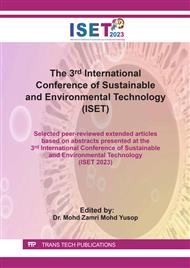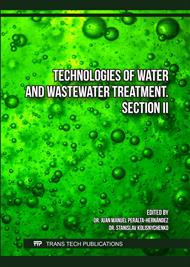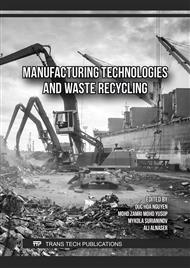[1]
R. Jamee and R. Siddique, Biodegradation of synthetic dyes of textile effluent by microorganisms: an environmentally and economically sustainable approach, Eur. J. Microbiol. Immunol. 9 (2019) 4.
DOI: 10.1556/1886.2019.00018
Google Scholar
[2]
S. Velusamy, A. Roy, S. Sundaram, and T. Kumar Mallick, A Review on Heavy Metal Ions and Containing Dyes Removal Through Graphene Oxide-Based Adsorption Strategies for Textile Wastewater Treatment, Chem. Rec. 21 (2021) 7.
DOI: 10.1002/tcr.202180701
Google Scholar
[3]
H. Yin, H. Guo, P. Qiu, L. Yi, and J. Li, Case analysis on textile wastewater subjected to combined physicochemical–biological treatment and ozonation, Desalin. Water Treat. 66 (2017) 140.
DOI: 10.5004/dwt.2017.1619
Google Scholar
[4]
X. C. Jin, G. Q. Liu, Z. H. Xu, and W. Y. Tao, Decolorization of a dye industry effluent by Aspergillus fumigatus XC6, Appl. Microbiol. Biot. 74 (2007) 1.
DOI: 10.1007/s00253-006-0658-1
Google Scholar
[5]
V. S. Munagapati and D. S. Kim, Adsorption of anionic azo dye Congo Red from aqueous solution by Cationic Modified Orange Peel Powder, J. Mol. Liq. 220 (2016) 540.
DOI: 10.1016/j.molliq.2016.04.119
Google Scholar
[6]
R. Jamee and R. Siddique, Biodegradation of synthetic dyes of textile effluent by microorganisms: an environmentally and economically sustainable approach, Eur. J. Microbiol. Immunol. 9 (2019) 4.
DOI: 10.1556/1886.2019.00018
Google Scholar
[7]
F. Q. Wang, Z. J. Chen, J. M Yang, W. J. Wang, Y. W. Feng, Z. Li and G. Sun, Labilibacter sediminis sp. nov., isolated from marine sediment, Int. J. Syst. Evol. Micr. 70 (2020) 1.
DOI: 10.1099/ijsem.0.003758
Google Scholar
[8]
K. Tait, D. A. White, S. A. Kimmance, G. Tarran, P. Rooks, M. Jones and C. A. Llewellyn, Characterisation of bacteria from the cultures of a Chlorella strain isolated from textile wastewater and their growth enhancing effects on the axenic cultures of Chlorella vulgaris in low nutrient media, Algal. Res. 44 (2019) 1-5.
DOI: 10.1016/j.algal.2019.101666
Google Scholar
[9]
R. Jamee and R. Siddique, Biodegradation of synthetic dyes of textile effluent by microorganisms: an environmentally and economically sustainable approach, Eur. J. Microbiol. Immunol. 9 (2019) 4.
DOI: 10.1556/1886.2019.00018
Google Scholar
[10]
A. E. Santhanarajan, W. J. Sul, K. J. Yoo, H. J. Seong, H. G. Kim, and S. C. Koh, Metagenomic insight of a full scale eco-friendly treatment system of textile dye wastewater using bioaugmentation of the composite culture CES-1, Microorganisms 9 (2021) 7.
DOI: 10.3390/microorganisms9071503
Google Scholar
[11]
W. G. Levine, Metabolism of azo dyes: Implication for detoxication and activation, Drug. Metab. Rev. 23 (1991) 3-4.
DOI: 10.3109/03602539109029761
Google Scholar
[12]
D. Shruthi Keerthi and M. Mukunda Vani, Optimization studies on decolorization of textile wastewater using natural coagulants, Mater. Today-Proc. 57 (2022) 1546.
DOI: 10.1016/j.matpr.2021.12.160
Google Scholar
[13]
Y. Chen, L. Zhang, L. Feng, G. Chen, Y.Wang, Z. Zhai and Q. Zhang, Exploration of the key functional strains from an azo dye degradation microbial community by DGGE and high-throughput sequencing technology, Environ. Sci. Pollut. R. 26 (2019) 24.
DOI: 10.1007/s11356-019-05781-z
Google Scholar
[14]
M. Martin, Cutadapt removes adapter sequences from high-throughput sequencing reads, Embnet J. 17 (2011) 1.
DOI: 10.14806/ej.17.1.200
Google Scholar
[15]
B. J. Callahan, P. J. McMurdie, M. J. Rosen, A. W. Han, A. J. A. Johnson, and S. P. Holmes, "DADA2: High-resolution sample inference from Illumina amplicon data, Nat. Methods 13 (2016) 7.
DOI: 10.1038/nmeth.3869
Google Scholar
[16]
R. C. Edgar, MUSCLE: Multiple sequence alignment with high accuracy and high throughput, Nucleic Acids Res. 32 (2004) 5.
DOI: 10.1093/nar/gkh340
Google Scholar
[17]
M. N. Price, P. S. Dehal, and A. P. Arkin, FastTree 2 - Approximately maximum-likelihood trees for large alignments, Plos One 5 (2010) 3.
DOI: 10.1371/journal.pone.0009490
Google Scholar
[18]
Q. Yang, P. Xiong, P. Ding, L. Chu, and J. Wang, Treatment of petrochemical wastewater by microaerobic hydrolysis and anoxic/oxic processes and analysis of bacterial diversity, Bioresource Technol. 196 (2015) 169–175.
DOI: 10.1016/j.biortech.2015.07.087
Google Scholar
[19]
S. Lindemann, J. Tremblay, J. H. Vineis, L. W. Hugerth, and A. F. Andersson, Analysing Microbial Community Composition through Amplicon Sequencing: From Sampling to Hypothesis Testing, Front Microbiol. 8 (2017) 1.
DOI: 10.3389/fmicb.2017.01561
Google Scholar
[20]
J. Lu, Y. Zhang, J. Wu, and J. Wang, Nitrogen removal in recirculating aquaculture water with high dissolved oxygen conditions using the simultaneous partial nitrification, anammox and denitrification system, Bioresource Technol. 305 (2020) 2.
DOI: 10.1016/j.biortech.2020.123037
Google Scholar
[21]
H. Dong, H. Liu, X. Yang, H. Gong, H. Zhang, R. Wang, L. Yan and W. Mai, The Effect of Initial Conditions with Aerobic Biological Treatment on Aniline Dyeing Wastewater, Processes 9 (2021) 1329.
DOI: 10.3390/pr9081329
Google Scholar
[22]
L. Shi, N. Liu, G. Liu, and J. Fang, Bacterial Community Structure and Dynamic Changes in Different Functional Areas of a Piggery Wastewater Treatment System, Microorganisms 9 (2021) 10.
DOI: 10.3390/microorganisms9102134
Google Scholar
[23]
S. Tizazu, G. Tesfaye, B. Andualem, A. Wang, and A. Guadie, Evaluating the potential of thermo-alkaliphilic microbial consortia for azo dye biodegradation under anaerobic-aerobic conditions: Optimization and microbial diversity analysis, J. Environ. Manage. 323 (2022) 116235.
DOI: 10.1016/j.jenvman.2022.116235
Google Scholar
[24]
Y. M. Kolekar, H. N. Nemade, V. L. Markad, S. S. Adav, M. S. Patole, and K. M. Kodam, Decolorization and biodegradation of azo dye, reactive blue 59 by aerobic granules, Bioresource Technol. 104 (2012) 818–822.
DOI: 10.1016/j.biortech.2011.11.046
Google Scholar
[25]
W. Zhu, J. Chen, H. Zhang, S. Yuan, W. Guo, Q. Zhang and S. Zhang, Start-up phase optimization of pyrite-intensified hybrid sequencing batch biofilm reactor (PIHSBBR): Mixotrophic denitrification performance and mechanism, J. Environ. Manage. 330 (2023) 117232.
DOI: 10.1016/j.jenvman.2023.117232
Google Scholar
[26]
F. Ndayisenga, Z. Yu, B. Wang, G. Wu, H. Zhang, I. A. Phulpoto, J. Zhao and J.Yang, Thermophilic-operating environment promotes hydrogen-producing microbial growth in a lignocellulose-fed DF-MEC system for enhanced biohydrogen evolution, Process Saf. Environ.167 (2022) 213–224.
DOI: 10.1016/j.psep.2022.09.026
Google Scholar
[27]
Z. H. Wang, M. Xue, K. Huang, and Z. Liu, Textile dyeing wastewater treatment, Peter J. Hauser, (Ed), Advances in Treating Textile Effluent, Intech, Rijeka, 2011, p.91–116.
DOI: 10.5772/22670
Google Scholar
[28]
Y. Li, L. Liu, Q. Wang, J. Wu, T. Liu, H. Liu, Y. Hong and T. Huang, Enhanced anaerobic co-metabolism of coal gasification wastewater via the assistance of zero-valent iron, J. Water Process Eng. 40 (2021) 5-6.
DOI: 10.1016/j.jwpe.2020.101817
Google Scholar
[29]
J. Feng, J. Zhang, B. Tan, M. Li, H. Peng, J. He, Y. Zhang and J. Su, Microbial community and metabolic characteristics evaluation in start-up stage of electro-enhanced SBR for aniline wastewater treatment, J. Water Process Eng. 45 (2022) 5-7.
DOI: 10.1016/j.jwpe.2021.102489
Google Scholar
[30]
J. Brzeszcz, P. Kapusta, T. Steliga, and A. Turkiewicz, Hydrocarbon removal by two differently developed microbial inoculants and comparing their actions with biostimulation treatment, Molecules 25 (2020) 10.
DOI: 10.3390/molecules25030661
Google Scholar
[31]
M. Xu, P. Gao, H. Chen, X.Huang, Z. Xue, X. Shen, C. Li and J. Cao, Spatiotemporal distribution of microorganisms in a full-scale anaerobic baffled reactor–anoxic/oxic treatment plant for printing and dyeing wastewater, J Water Process Eng. 49 (2022) 4-6.
DOI: 10.1016/j.jwpe.2022.103090
Google Scholar




